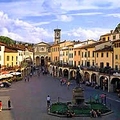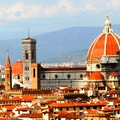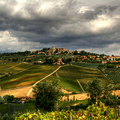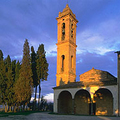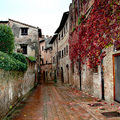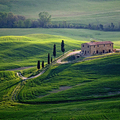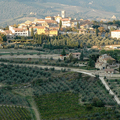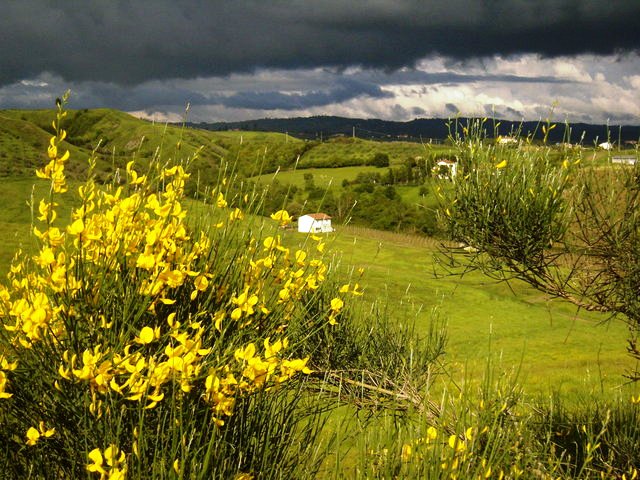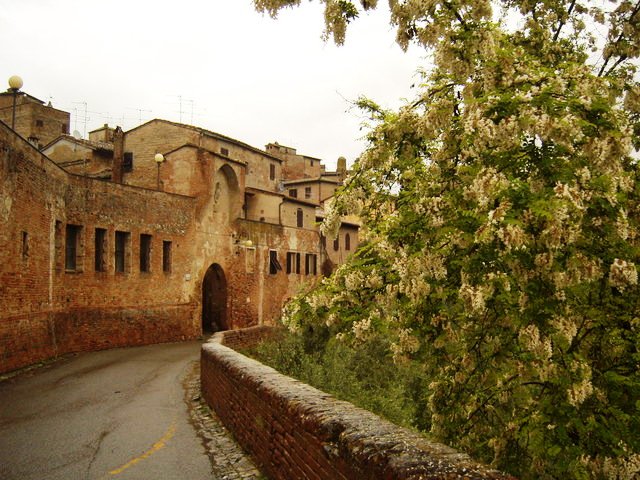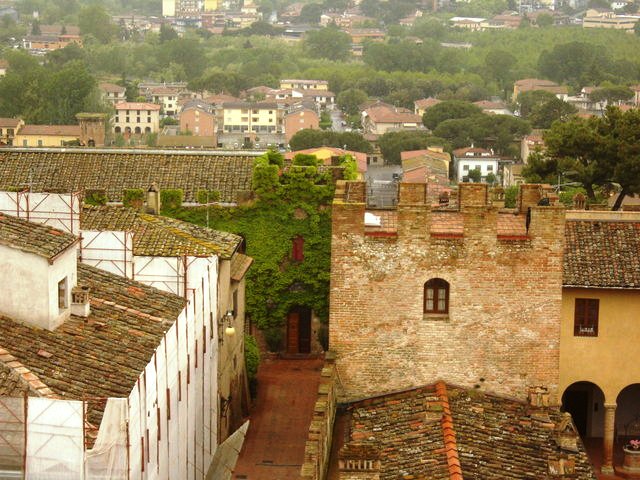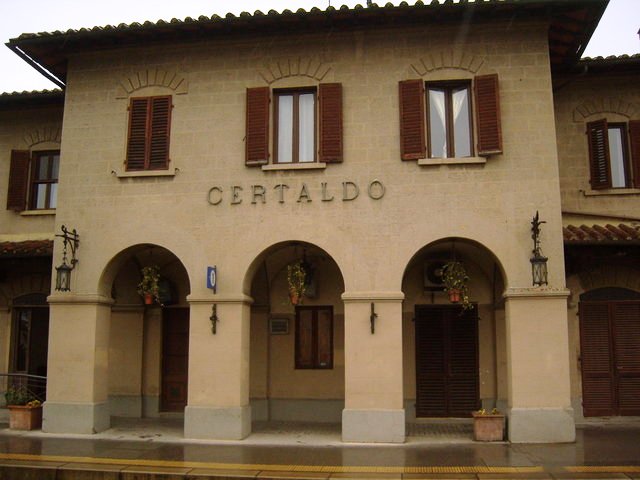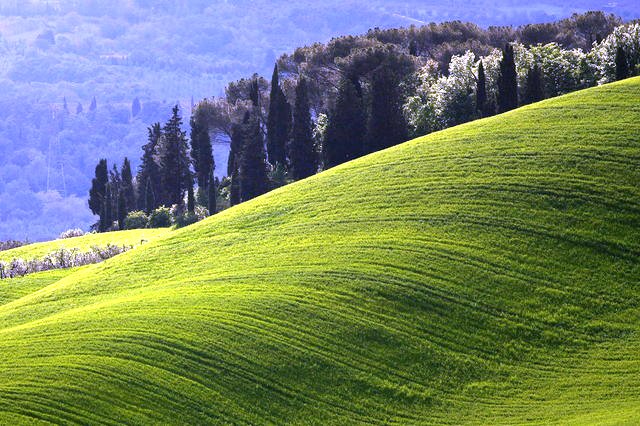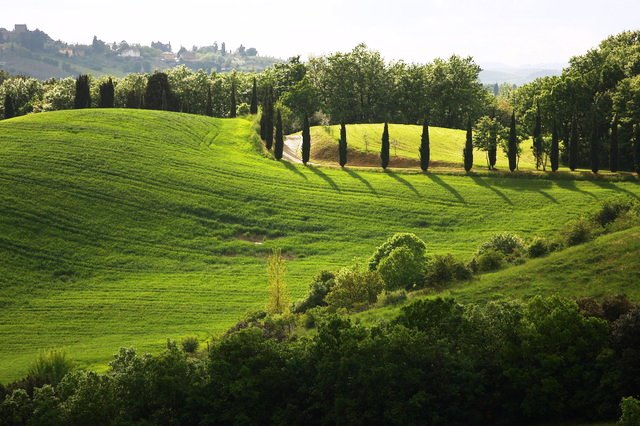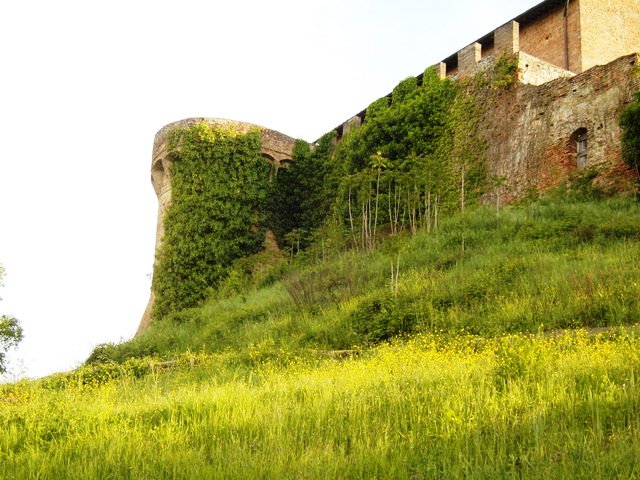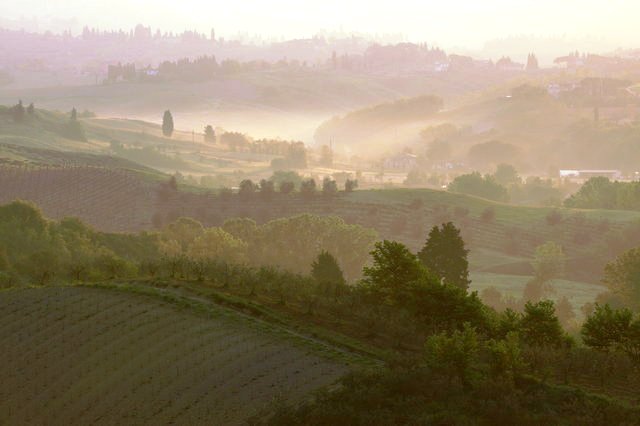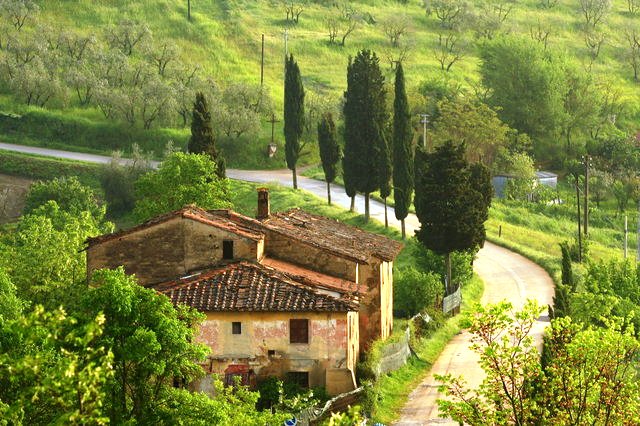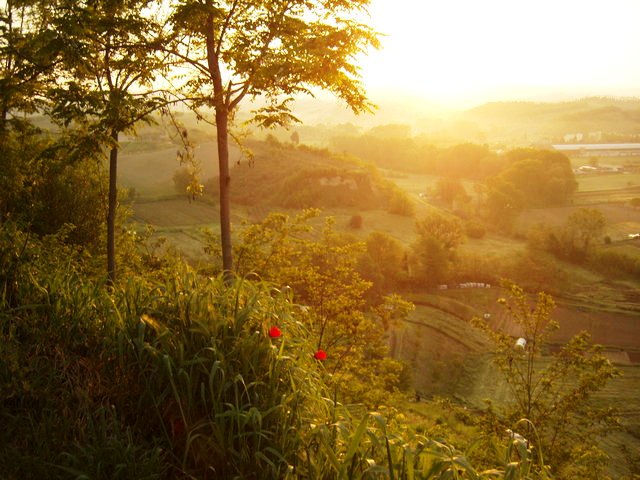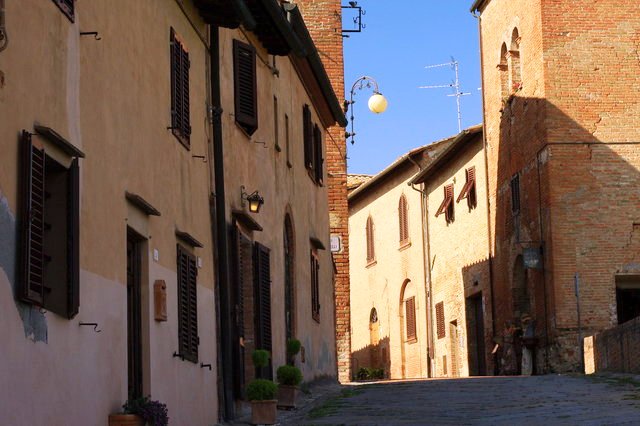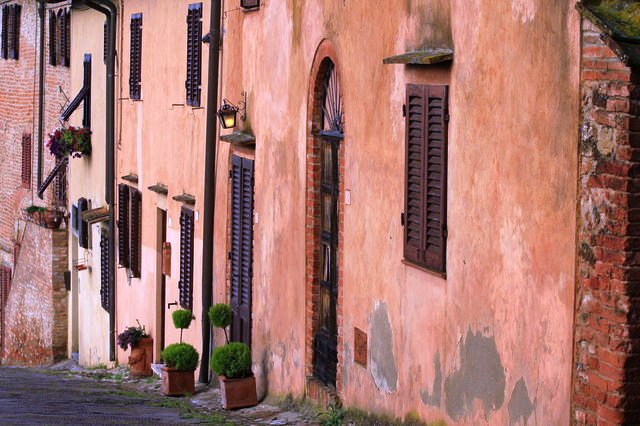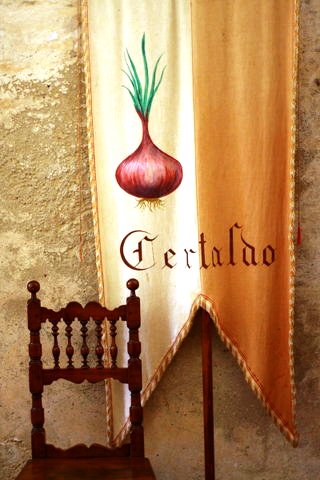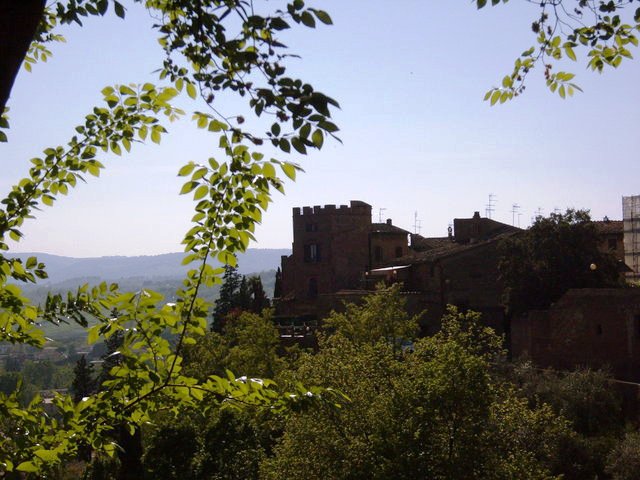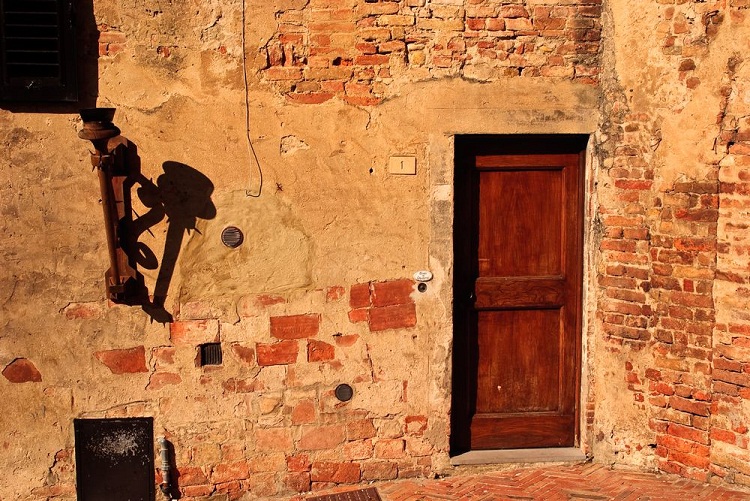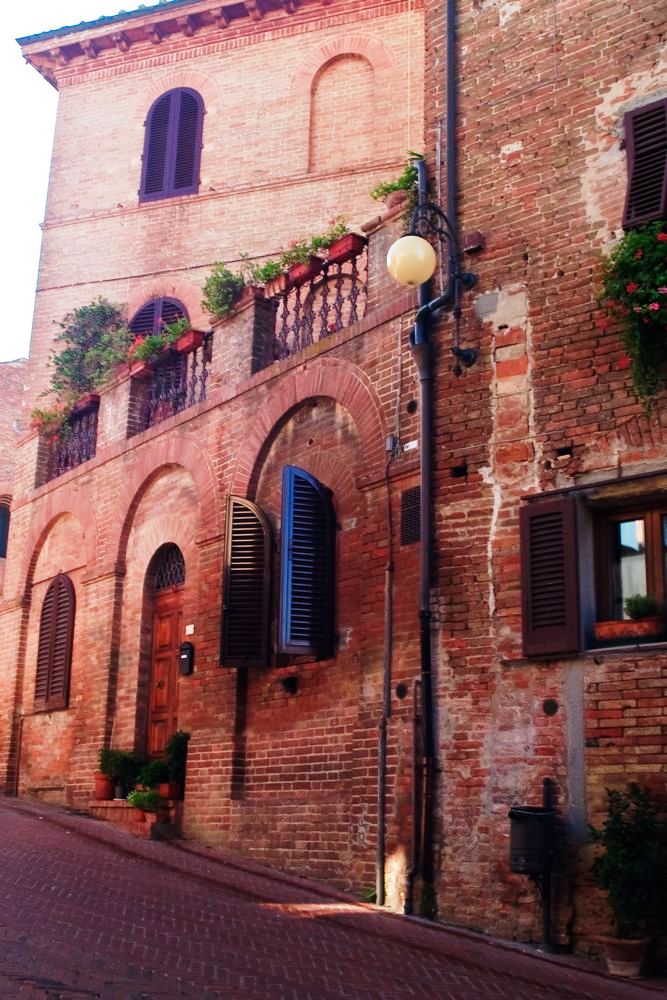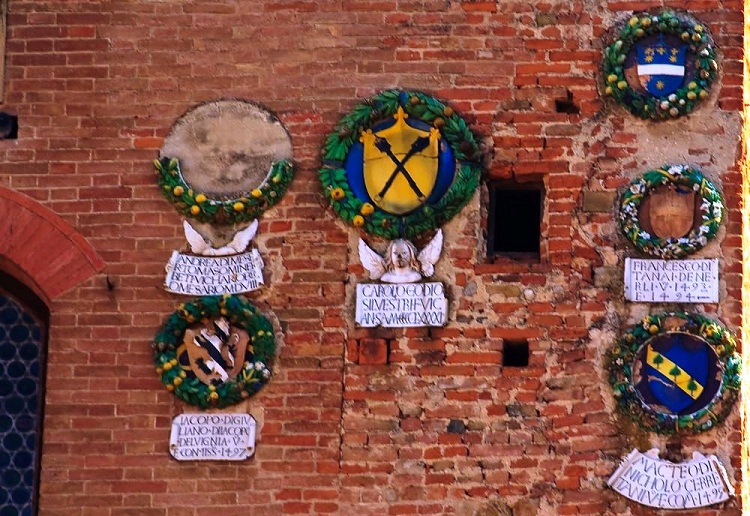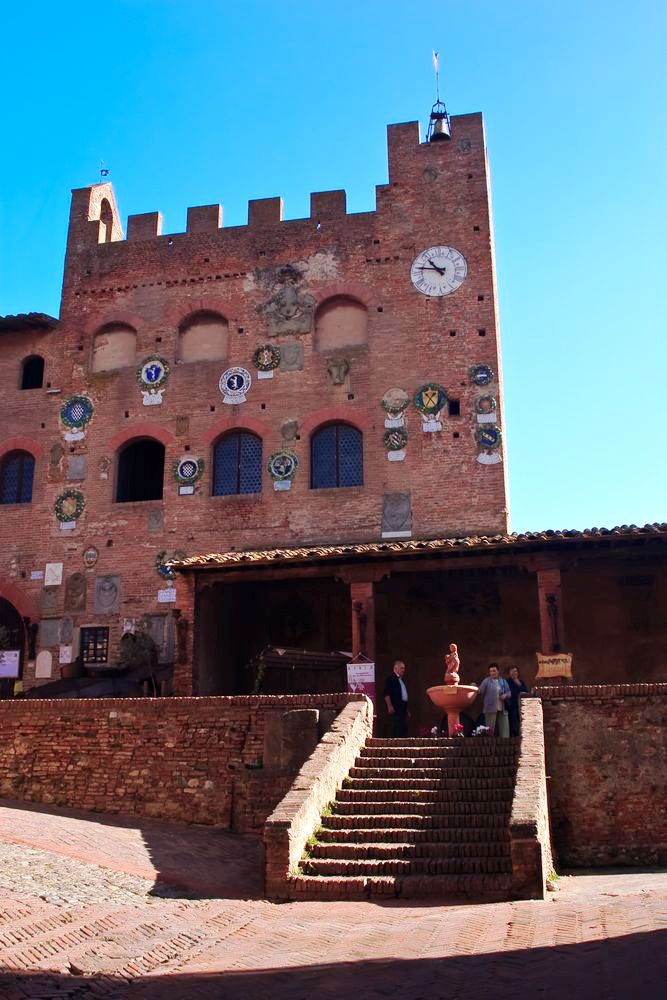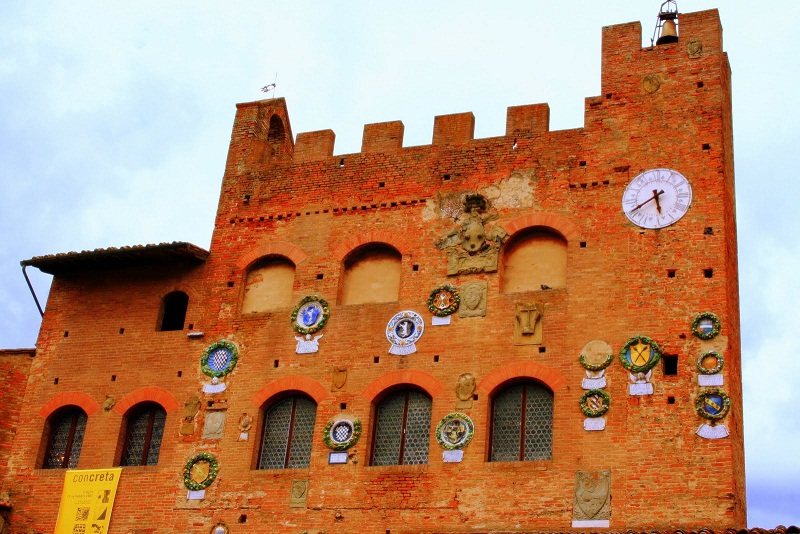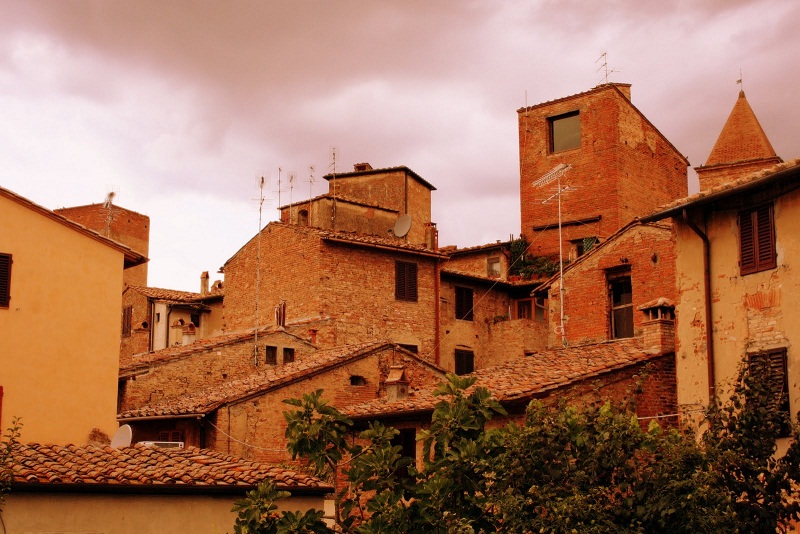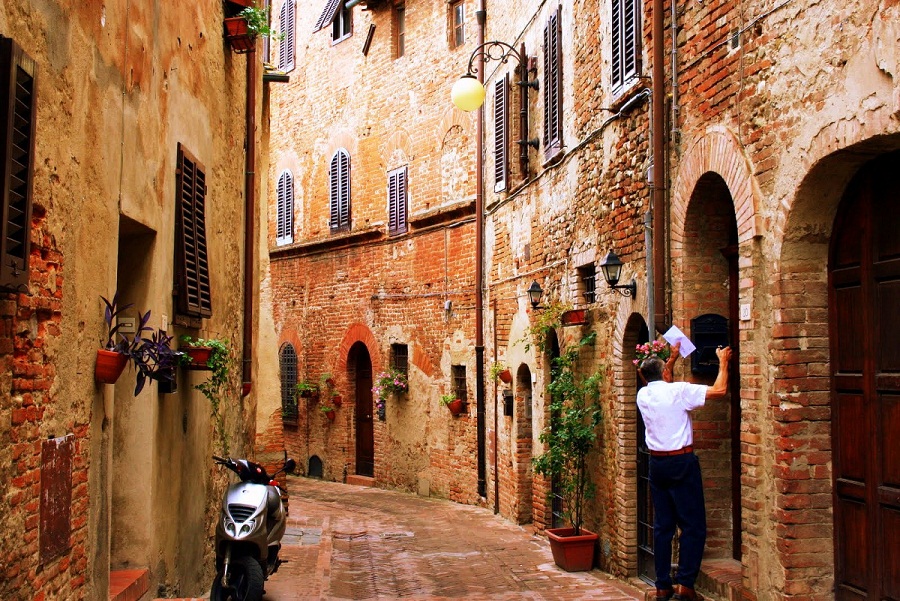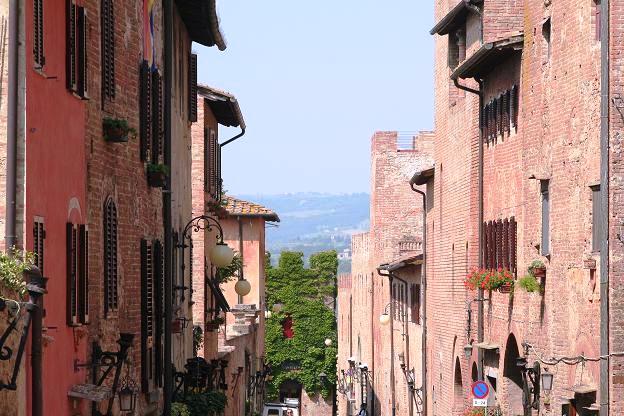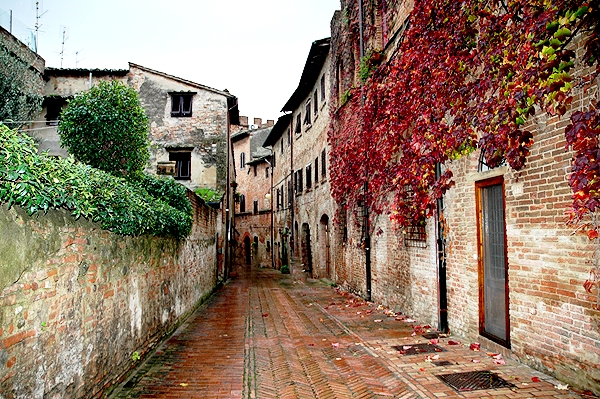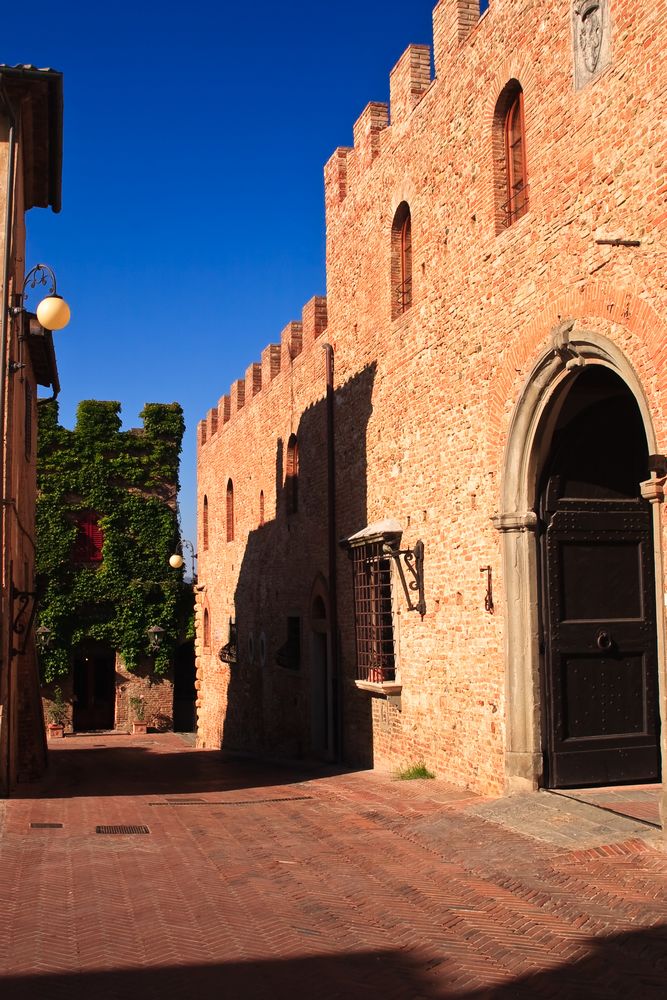About Certaldo
Certaldo is a beautiful medieval town in the Chianti territory. It is located in the southern part of the province of Florence in Tuscany, on the border between Florence and Siena province; it is also a short distance time away from San Gimignano, whose famous towers can be admired from here. The municipality of Certaldo is spread out over an area of approximately 75 square kilometers on one of the hills that divides Val d'Elsa from the Val di Pesa. The town enjoys a gorgeous positioning, among lush rolling hills covered with fields, olive grooves and cypresses trees. Besides, Certaldo can be considered one of the best preserved ancient settlements in Tuscany. The town is renowned mainly for two things: the sweet purple onions that people grow here (cipolle di Certaldo) and, more important, Certaldo is famous as the birthplace of the 14th-century writer Giovanni Boccaccio, as well as the place where he spent his final thirteen years of his life. The main local industries in Certaldo are agriculture, wine, furniture and shoe making. Certaldo has not become a major tourist destination in the area, managing to maintain the character of a small medieval town that has not been beseiged by tourists yet. For this reason, many travelers like to visit the town in order to experience the medieval atmosphere and laid back lifestyle in this genuine Tuscan town. Visitors will find here beautiful ancient architecture, winding cobble stoned streets and numerous secular villas, together with historical attractions. A vantage point of tourists is that getting to Certaldo is easy, as the town is located in the proximity of two major cities, Siena and Florence. Tourists interested in visiting Certaldo can take a flight to Florence and take a bus or taxi from here. Besides buses and taxis, tourists can travel by train as well. Certaldo is connected relatively well by railway to these cities, as well as other smaller towns in the province of Florence.
History of Certaldo
Certaldo is one of the major centres of the Val d'Elsa. The town was born on the site of an ancient settlement located in the Val d'Elsa. The name derives from the Latin phrase "Cerrus Altus" or from the Germanic “cerrus aldo”, a reference to the fact that the area was at that time was covered by oaks. According to the archeological finds that were discovered in the area, among which several tombs, remains of temples, inscriptions and ancient coins, the history of the town goes back to the Etruscan ages, being inhabited by the Etruscans. The area of Certaldo has later become a Roman colony. Yet starting with this period and up until the early Middle Ages, the history of the town is little known. The first document that mentions Certaldo is a certificate by Federico Barbarossa dating from 1164. In the 10th century AD, Certaldo was a feudal castle under the control of the powerful Alberti Counts from Prato. At the ending of the 12th century, Count Alberto degli Alberti has been imprisoned by the Florentines. In exchange for his freedom, he destroyed the tower of Certaldo in 1184 and passed the castle to Florence. After the destruction of the nearby Fortress of Semifonte in 1202, which brought the definitive collapse for the Alberti Counts, the citadel became incorporated in the county of Florence, becoming Seat of a Podesta. Once accepting the rule of Florence, the history of Certaldo is indistinguishable from that of Florence. Under their control, the city registered a period of great progress, mostly due to the fact that the town was located in the proximity of Via Francìgena, an important road, pilgrimage and trade route to France. Certaldo extended greatly, with additional settlements rising down the hillsides below the original village, along the Via Francìgena. In 1415, Certaldo became the Vicariate Capital of the Val di Pesa and of part of the Val d'Elsa and Valdarno Inferiore, an important centre for local administration. To match the new status, the castle was enlarged and was enclosed into stone walls. The majestic Palazzo Pretorio was erected on the same site where in ancient times the seat of the Alberti Counts used to stand. In 1479, Certaldo was assaulted by the troops of of Fernando I, King of Naples and Pope Sextus IV, allied with Sienna. As a result, the town felt under the dominion of Sienna. Later on, it passed under the jurisdiction of the Grand Duchy of Tuscany –under this rule, it registered a development period both socially and economically, particularly in the lower part called the "village". The construction of the railroad has had a major impact, materialized in the increase of manufacturing and trade activity. During the Second World War, the city suffered damages, yet has succeeded in recovering rapidly and it is nowadays a great agricultural and industrial centre. Tourists visit Certaldo for its historical buildings, almost perfectly preserved, and for the picturesque landscapes of the area.
Major attractions to visit in Certaldo
Like many other Tuscan towns, Certaldo is divided into two districts. The upper part, called Certaldo Alto or Rione Castello, is also the most ancient part. It is located on the highest grounds of the hill and is encircled by fortification walls that enclose medieval surroundings, including an ancient citadel. This part of the town can be reached on foot in about 10 minutes or by cablecar from the station in the main piazza in approximatively 2 minutes. It built almost entirely of brick, and the architecture is mostly intact in spite of the fact that some damage have occurred during the Second World War. All the main buildings, together with some gorgeous houses, face onto Via Boccaccio, with a tower and loggia. Rebuilt in 1947, the house was bought and renovated in the early 19th century by Marchesa Carlotta dei Medici Lenzoni. Nearby the little piazza, the church of Santi Michele e Jacopo can be found, dating from the 13th century. The church boasts a simple brick facade and has been restored to original Romanesque appearance. The lower part, called Certaldo Bassa, is the modern residential and industrial suburb spread out below, representing the more modern and industrialized part of the town. In this part of the town there is the main square Piazza Boccaccio with a splendid marble statue by Augusto Passaglia. Before you start exploring this wonderful place, we advise you to enjoy the beautiful scenery that opens up, the luxuriant Val d’Elsa hills and somewhere in the distance, the towers of San Gimignano. If you have ever seen the movie "Shadow Dancer", you will certainly recognize in Certaldo the narrow streets and buildings with simple architecture. With one ticket, you can visit the three important landmarks of Certaldi: Boccaccio museum, Museum of Sacred Art and Palazzo Pretorio.
The ancient centre of the town is located inside the medieval defensive walls. There are three ancient doors that allowed access to the central core and these are Porta Alberti, Porta al Sole and Porta al Rivellino. Visitors can get to the ancient centre by walking on Via Costa Alberti and Costa Vecchia, as well as the more modern Via del Castello. The centre can also be reached through a funicular railway, departing from piazza Boccaccio. Due to the fact that Certaldo is positioned on the slopes of a hillside, there was not enough space for a large piazza here. Hence, the major buildings were erected along via Boccaccio, among which the seat of the church; the building of civic power, Palazzo Pretorio; the Market Loggia and Palazzo Stiozzi Ridolfi, closed today but whose ancient walls still stand nowadays. The current squares that exist in Certaldo were gardens in the past, feeding citizens in war times.
A visit to Certaldo may start from the house of its most notorious citizen, Giovanni Boccaccio, one of the greatest Renaissance humanist writers and poets, worldwide known as the author of the “Decameron”, “On Famous Women” and poetry in vernacular language. He was born here in 1313 (d. 1375) and died on December 21, 1375, being buried also here. Certaldo was the home of his family. He was the illegitimate son of a Florentine banker originating from Certaldo and a French unknown woman. His house, transformed into a small museum and library now, can be reached along Via Boccaccio, midway down from Certaldo Alto. The façade of the house alike most buildings here, is made of bricks. Restored in 1823, the house was arranged with old furniture at that time, while a statue dedicated to the famous writer was erected in the main square in 1875. The structure has suffered serious damages during the World War II, being almost completely rebuilt after that. On the ground floor audiovisual displays depict main things about the life and work of the poet. In the Poet's room one can admire a fresco by Pietro Benvenuti (1769-1844) that survived the bombing. Nowadays it houses the “Centro Nazionale di Studi sul Boccaccio” ( or National Centre of studies on Boccaccio in translations), containing a large number of foreign translations of the Decameron. The Casa del Boccaccio is is open daily except Mondays. Nearby the house of Boccaccio, Church of Saint Michael and Jacob stands, dating from the 13th century and built in Romanesque style. The church has a single nave and contains a remarkable 14th century fresco by a Sienese artist called “Madonna Enthroned with Saints”. Also here, the tomb of the illustrious writer of Certaldo can be found.
Also in the upper part of the city at the top of the street, on Piazza del Vicariato in Certaldo Alto, where numerous medieval buildings in a very good shape stand, you can visit the Palazzo del Vicario or Palazzo Pretorio (the Praetorian Palace), which was originally the residence of the Counts Alberti and later on, of the Florentine governors. Palazzo Pretorio is the most representative monument in Certaldo. Built in the late 12th century atop the ruins of the family's former homes, the palazzo has been recently restored to its original condition. The building has arched windows a facade decorated with merlons and a tower, and a court adorned with coats of arms in stone and glazed terracotta, representing the families of each of the vicars that lived in and governed from there. Today, visitors can see the prisons, the meeting rooms, the archive, the chapel and the private lodgings of the vicars. The interior is decorated with frescoes dating from the I3th to the 16th century. Do not miss the Knights Room with paintings by Francesco Fiorentino (1445-1497), the “Madonna and Child” and “Dead Christ”, and the Audience Hall with paintings of Francesco Fiorentino too, the “Pietà” and “Doubting Thomas”. Besides frescoes, several rooms feature fine doorways and fireplaces. Being the highest building in town, Palazzo Pretorio offers gorgeous views over the entire area of Certaldo. Palazzo Pretorio is open for visitors except Monday. Next to Palazzo Pretorio there is the Church and the Cloister of Saint Thomas, which dates back to the 13th century. The church houses some frescos by Benozzo Gozzoli. The Stiozzi palace is another important palace in the town. Although it is not as impressive as the Pretoria palace, a visit here will bring you back closer to the history of the place. The palace is much smaller in size and boasts renaissance style architecture.
Art lovers will enjoy visiting the Museum of Sacred Art. Originally an Augustinian convent from the 15th century, Museo d'Arte Sacra was inaugurated on June 30, 2001. The museum contains a collection of religious art works in the form of ancient sacred vessels, among which a wooden crucifix from the San Pietro a Petrognano church, dating from the 13th century, the so-called "Christ Triumphant", together with paintings by Meliore, the Bigallo master Puccio di Simone and Ugolino di Nerio, gathered from the churches in the countryside around Certaldo over the centuries. It is open daily from 10.00-19.00.
Festivals in Certaldo
Certaldo hosts numerous famous festivals all around the year, among which the Mercantia is one of the most important. This festival lasts for one week and it is held here annually in the last days of July. During the celebration, troops and groups that come here from all over Italy and Europe offer street performances. Singers, dancers and performers along with artisans all demonstrate their crafts here. The atmosphere during the festival is very warm, gathering people from all over Tuscany as well as other parts of Italy. Another important festival here is the fish festival. The festival is a month long and it is held yearly from mid May to mid June. The festival is beloved by food lovers specifically, as there are sold various local fish dishes among which the famous fish soup "Caciucco alla livornese" during the festival. Besides, a crafts fair/flea market is held on Sundays. Among special festivals, there is the song festival called Certaldo Sotto le Stelle that takes place in early September.
Accommodation in Certaldo
Although Certaldo is not a very large city, it still offers many good places to accommodate yourself at. Most hotels are located within a short distance from the center of the town and around the main Piazza. The most famous hotels here are hotel Certaldo, Hotel Albergo Castello and Hotel La Sperenza. You can find rooms at low prices even without making a prior reservation. There are also available farmhouses run by local people, for those interested in discovering the Tuscan authentic lifestyle. Bed & breakfasts options are available too.
Eating in Certaldo
The cuisine in Certaldo is based on medieval traditions, with the famous purple Certaldo onion used in a great variety of local specialties. Additionally, the famous Chianti wine will bring the extra flavour and spice. There are a few good restaurants, pizzerias, bars and cafes in Certaldo. Most of these have on the menu Italian and Tuscan dishes prepared from fresh products. Some of the best restaurants here are Messer Boccaccio, Osteria Del Vicaro, Pizzeria Pirata, Pizzeria O' Vessuvio and Pizzeria Albergo Bissetto. There are also several wine shops, offering a large diversity of wines at relatively low prices.
By Maria Morari
Others
The most beautiful places to visit in Chianti area, Italy .
Chianti is a picturesque area in Tuscany, Italy which is worldwide known for its red wine of the same name.
Alike the entire area of Tuscany, Chianti has it all to satisfy the visitor and make him never leave this paradise place, to be mentioned the great wine, delicious dishes, and splendid untainted nature.
Check out the best places to visit in the Chianti area!

